2003 INFINITI G35 steering
[x] Cancel search: steeringPage 17 of 256
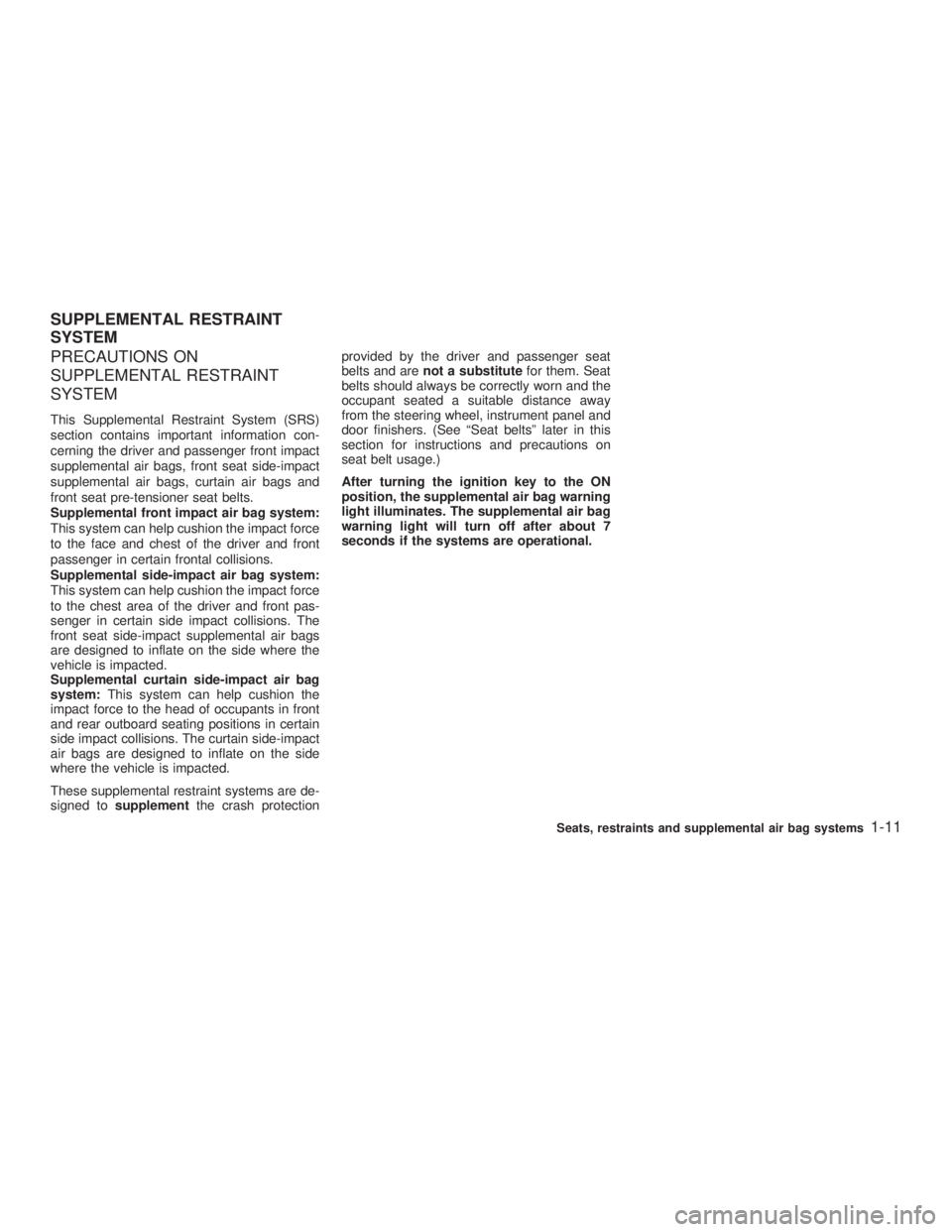
PRECAUTIONS ON
SUPPLEMENTAL RESTRAINT
SYSTEM This Supplemental Restraint System (SRS)
section contains important information con-
cerning the driver and passenger front impact
supplemental air bags, front seat side-impact
supplemental air bags, curtain air bags and
front seat pre-tensioner seat belts.
Supplemental front impact air bag system:
This system can help cushion the impact force
to the face and chest of the driver and front
passenger in certain frontal collisions.
Supplemental side-impact air bag system:
This system can help cushion the impact force
to the chest area of the driver and front pas-
senger in certain side impact collisions. The
front seat side-impact supplemental air bags
are designed to inflate on the side where the
vehicle is impacted.
Supplemental curtain side-impact air bag
system: This system can help cushion the
impact force to the head of occupants in front
and rear outboard seating positions in certain
side impact collisions. The curtain side-impact
air bags are designed to inflate on the side
where the vehicle is impacted.
These supplemental restraint systems are de-
signed to supplement the crash protection provided by the driver and passenger seat
belts and are not a substitute for them. Seat
belts should always be correctly worn and the
occupant seated a suitable distance away
from the steering wheel, instrument panel and
door finishers. (See ªSeat beltsº later in this
section for instructions and precautions on
seat belt usage.)
After turning the ignition key to the ON
position, the supplemental air bag warning
light illuminates. The supplemental air bag
warning light will turn off after about 7
seconds if the systems are operational.SUPPLEMENTAL RESTRAINT
SYSTEM
Seats, restraints and supplemental air bag systems
1-11
Z 02.7.29/V35-D/V5.0
X
Page 18 of 256
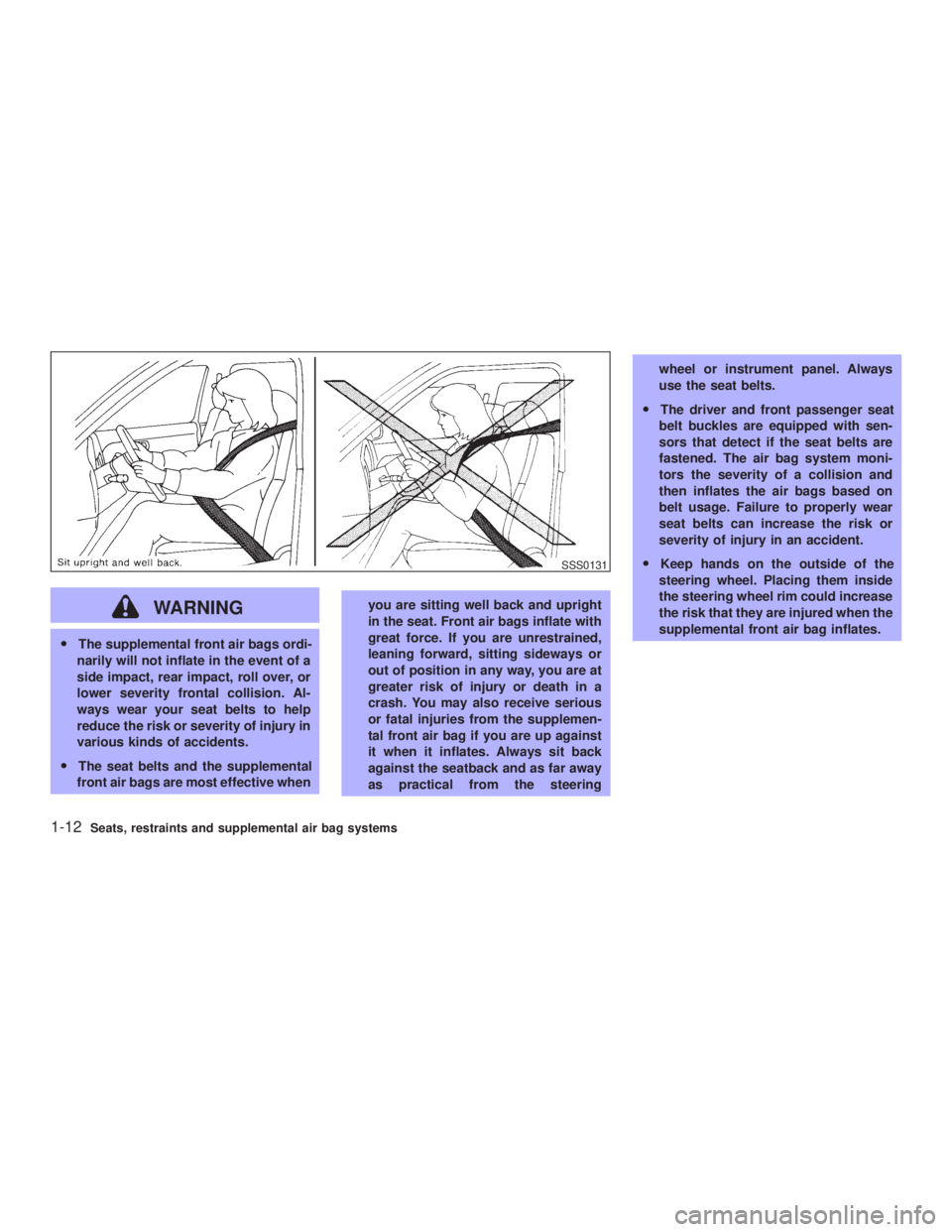
WARNINGO The supplemental front air bags ordi-
narily will not inflate in the event of a
side impact, rear impact, roll over, or
lower severity frontal collision. Al-
ways wear your seat belts to help
reduce the risk or severity of injury in
various kinds of accidents.
O The seat belts and the supplemental
front air bags are most effective when you are sitting well back and upright
in the seat. Front air bags inflate with
great force. If you are unrestrained,
leaning forward, sitting sideways or
out of position in any way, you are at
greater risk of injury or death in a
crash. You may also receive serious
or fatal injuries from the supplemen-
tal front air bag if you are up against
it when it inflates. Always sit back
against the seatback and as far away
as practical from the steering wheel or instrument panel. Always
use the seat belts.
O The driver and front passenger seat
belt buckles are equipped with sen-
sors that detect if the seat belts are
fastened. The air bag system moni-
tors the severity of a collision and
then inflates the air bags based on
belt usage. Failure to properly wear
seat belts can increase the risk or
severity of injury in an accident.
O Keep hands on the outside of the
steering wheel. Placing them inside
the steering wheel rim could increase
the risk that they are injured when the
supplemental front air bag inflates. SSS0131
1-12 Seats, restraints and supplemental air bag systems
Z 02.7.29/V35-D/V5.0
X
Page 24 of 256

The driver supplemental air bag is located in
the center of the steering wheel; the front
passenger supplemental air bag is mounted in
the instrument panel above the glove box.
These systems are designed to meet optional
certification requirements under U.S. regula- tions. They are also permitted in Canada. The
optional certification allows front air bags to be
designed to inflate somewhat less forcefully
than previously. However, all of the informa-
tion, cautions and warnings in this manual
still apply and must be followed. The front air bags are designed to inflate in higher
severity frontal collisions, although they may
inflate if the forces in another type of collision
are similar to those of a higher severity frontal
impact. They may not inflate in certain frontal
collisions. Vehicle damage (or lack of it) is not
always an indication of proper supplemental
air bag operation.
The supplemental air bag system has dual
stage inflators for both the driver and passen-
ger air bags. The system monitors information
from the crash zone sensor, the diagnosis
sensor unit and seat belt buckle sensors that
detect if the seat belts are fastened, inflator
operation is based on the severity of a collision
and whether the seat belts are being used.
Only one front air bag may inflate in a crash,
depending on the crash severity and whether
the front occupants are belted or unbelted.
This does not indicate improper performance
of the system. If you have any questions about
the performance of your air bag system,
please contact your INFINITI retailer.
When the supplemental front air bag inflates, a
fairly loud noise may be heard, followed by
release of smoke. This smoke is not harmful
and does not indicate a fire. Care should be
taken not to inhale it, as it may cause irritation
and choking. Those with a history of a breath- SSS0221
1-18 Seats, restraints and supplemental air bag systems
Z 02.7.29/V35-D/V5.0
X
Page 25 of 256
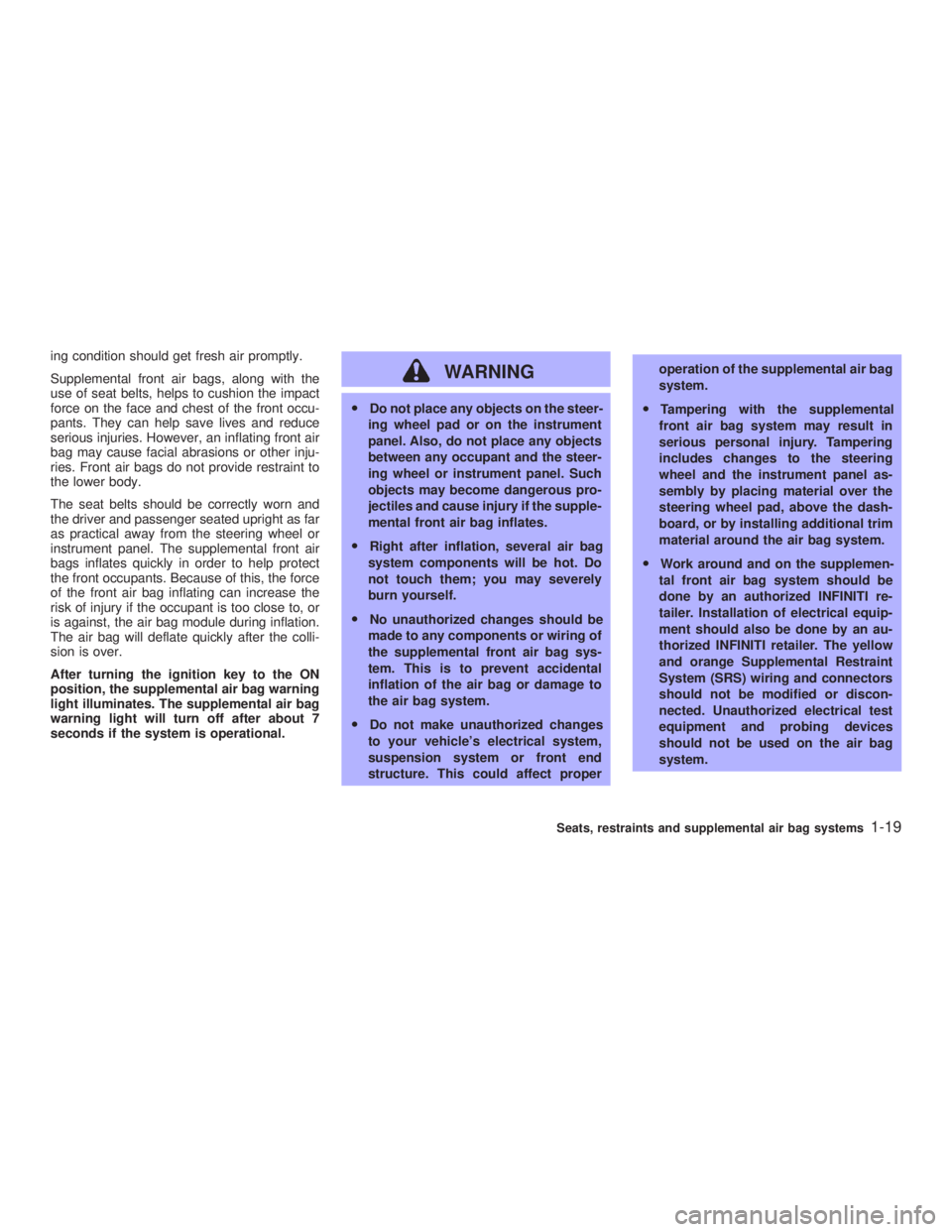
ing condition should get fresh air promptly.
Supplemental front air bags, along with the
use of seat belts, helps to cushion the impact
force on the face and chest of the front occu-
pants. They can help save lives and reduce
serious injuries. However, an inflating front air
bag may cause facial abrasions or other inju-
ries. Front air bags do not provide restraint to
the lower body.
The seat belts should be correctly worn and
the driver and passenger seated upright as far
as practical away from the steering wheel or
instrument panel. The supplemental front air
bags inflates quickly in order to help protect
the front occupants. Because of this, the force
of the front air bag inflating can increase the
risk of injury if the occupant is too close to, or
is against, the air bag module during inflation.
The air bag will deflate quickly after the colli-
sion is over.
After turning the ignition key to the ON
position, the supplemental air bag warning
light illuminates. The supplemental air bag
warning light will turn off after about 7
seconds if the system is operational. WARNING O Do not place any objects on the steer-
ing wheel pad or on the instrument
panel. Also, do not place any objects
between any occupant and the steer-
ing wheel or instrument panel. Such
objects may become dangerous pro-
jectiles and cause injury if the supple-
mental front air bag inflates.
O Right after inflation, several air bag
system components will be hot. Do
not touch them; you may severely
burn yourself.
O No unauthorized changes should be
made to any components or wiring of
the supplemental front air bag sys-
tem. This is to prevent accidental
inflation of the air bag or damage to
the air bag system.
O Do not make unauthorized changes
to your vehicle's electrical system,
suspension system or front end
structure. This could affect proper operation of the supplemental air bag
system.
O Tampering with the supplemental
front air bag system may result in
serious personal injury. Tampering
includes changes to the steering
wheel and the instrument panel as-
sembly by placing material over the
steering wheel pad, above the dash-
board, or by installing additional trim
material around the air bag system.
O Work around and on the supplemen-
tal front air bag system should be
done by an authorized INFINITI re-
tailer. Installation of electrical equip-
ment should also be done by an au-
thorized INFINITI retailer. The yellow
and orange Supplemental Restraint
System (SRS) wiring and connectors
should not be modified or discon-
nected. Unauthorized electrical test
equipment and probing devices
should not be used on the air bag
system.
Seats, restraints and supplemental air bag systems
1-19
Z 02.7.29/V35-D/V5.0
X
Page 56 of 256

1. Headlight, fog light and turn signal switch
(P.2-17)
2. Steering switch for audio control (P.4-16)
3. Driver supplemental air bag (P.1-8)/Horn
(P.2-21)
4. Meters/gauges (P.2-3) 5. Cruise control main/set switch (P.5-11)
6. Windshield wiper/washer switch (P.2-16)
7. Center ventilator (P.4-2)
8. Center display - Compass (P.2-6), Air con-
ditioner (P.2-6), Ambient temperature
(P.2-6) 9. Rear window and outside mirror (if so
equipped) defogger switch (P.2-16)
10. Heater/air conditioner control (P.4-3)
11. Clock (P.2-23)
12. Navigation system* (if so equipped)
13. Security indicator light (P.2-14)
14. Passenger supplemental air bag (P.1-8)
15. Upper glove box (Except for Navigation
system equipped models) (P.2-26)
16. Side window defroster
17. Side ventilator (P.4-2)
18. Hood lock release handle (P.3-9)
19. Instrument brightness control switch
(P.2-19)
20. Trunk lid release switch (P.3-11)
21. VDC (Vehicle Dynamics Control) OFF
switch (P.2-22)
22. Outside mirror remote control (P.3-15)
23. Fuse box (P.8-20)
24. Tilting steering wheel lock lever (P.3-14)
25. Ignition switch/steering lock (P.5-4)
26. Cigarette lighter (P.2-24)
27. Ashtray (P.2-24)/Pocket
28. Radio/cassette player (P.4-8)/CD player
(P.4-8)
29. Hazard warning flasher switch (P.2-20)
30. Heated seat switch (P.2-21)
31. Power outlet
32. Glove box (P.2-26) SIC2023INSTRUMENT PANEL
2-2 Instruments and controls
Z 02.7.29/V35-D/V5.0
X
Page 75 of 256
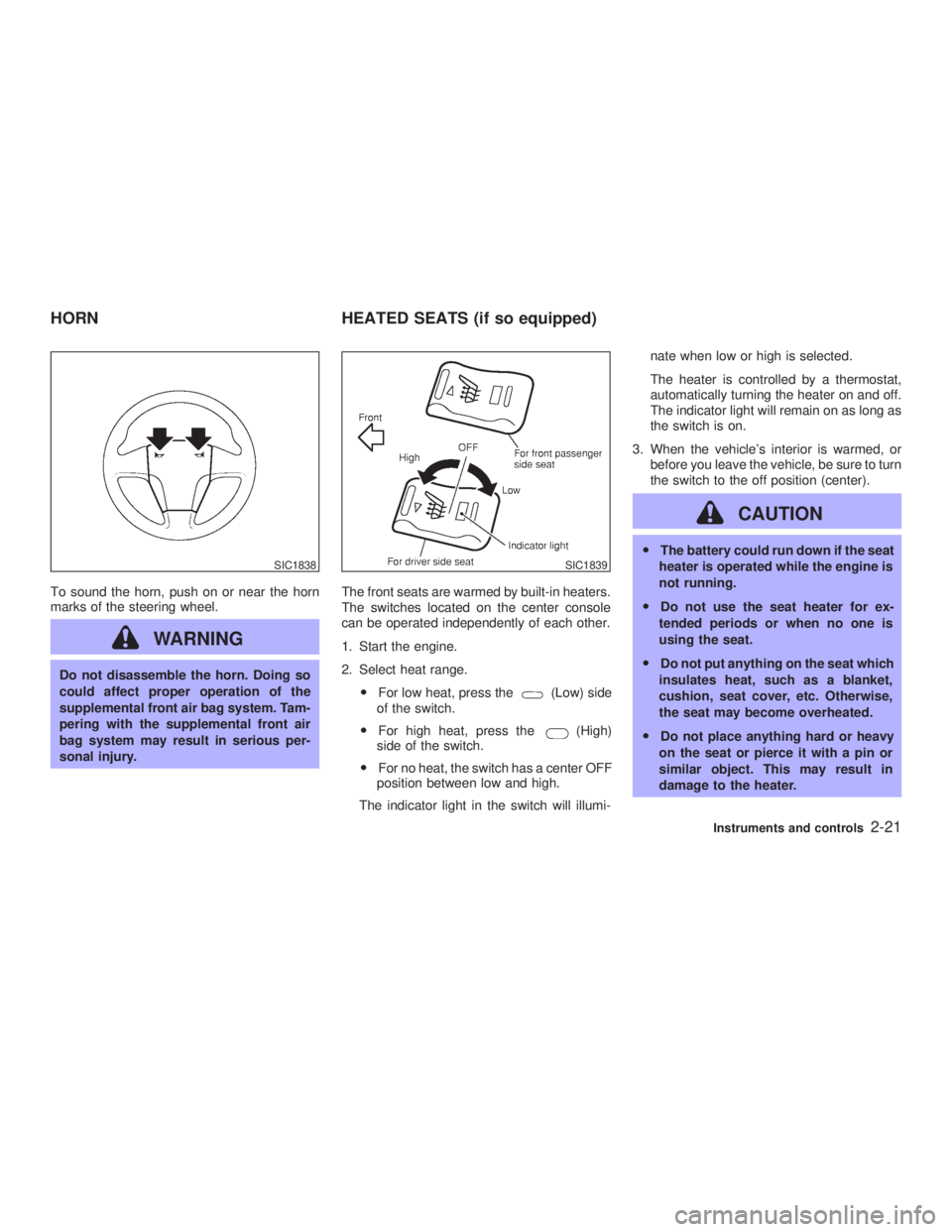
To sound the horn, push on or near the horn
marks of the steering wheel.
WARNINGDo not disassemble the horn. Doing so
could affect proper operation of the
supplemental front air bag system. Tam-
pering with the supplemental front air
bag system may result in serious per-
sonal injury. The front seats are warmed by built-in heaters.
The switches located on the center console
can be operated independently of each other.
1. Start the engine.
2. Select heat range.
O For low heat, press the (Low) side
of the switch.
O For high heat, press the (High)
side of the switch.
O For no heat, the switch has a center OFF
position between low and high.
The indicator light in the switch will illumi- nate when low or high is selected.
The heater is controlled by a thermostat,
automatically turning the heater on and off.
The indicator light will remain on as long as
the switch is on.
3. When the vehicle's interior is warmed, or
before you leave the vehicle, be sure to turn
the switch to the off position (center).
CAUTION O The battery could run down if the seat
heater is operated while the engine is
not running.
O Do not use the seat heater for ex-
tended periods or when no one is
using the seat.
O Do not put anything on the seat which
insulates heat, such as a blanket,
cushion, seat cover, etc. Otherwise,
the seat may become overheated.
O Do not place anything hard or heavy
on the seat or pierce it with a pin or
similar object. This may result in
damage to the heater.SIC1838 SIC1839
HORN HEATED SEATS (if so equipped)
Instruments and controls
2-21
Z 02.7.29/V35-D/V5.0
X
Page 95 of 256
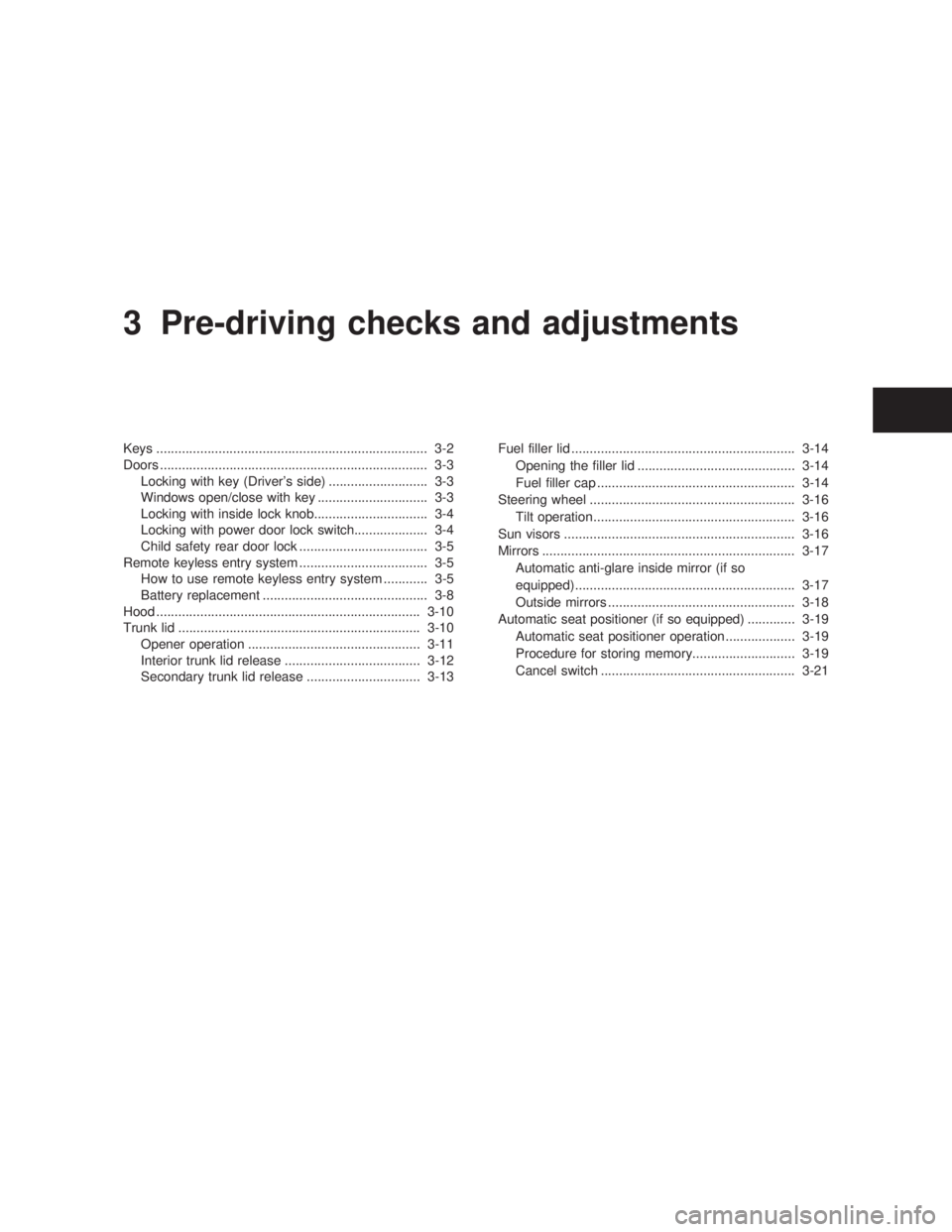
3 Pre-driving checks and adjustments Keys .......................................................................... 3-2
Doors ......................................................................... 3-3
Locking with key (Driver's side) ........................... 3-3
Windows open/close with key .............................. 3-3
Locking with inside lock knob............................... 3-4
Locking with power door lock switch.................... 3-4
Child safety rear door lock ................................... 3-5
Remote keyless entry system ................................... 3-5
How to use remote keyless entry system ............ 3-5
Battery replacement ............................................. 3-8
Hood ........................................................................ 3-10
Trunk lid .................................................................. 3-10
Opener operation ............................................... 3-11
Interior trunk lid release ..................................... 3-12
Secondary trunk lid release ............................... 3-13 Fuel filler lid ............................................................. 3-14
Opening the filler lid ........................................... 3-14
Fuel filler cap ...................................................... 3-14
Steering wheel ........................................................ 3-16
Tilt operation....................................................... 3-16
Sun visors ............................................................... 3-16
Mirrors ..................................................................... 3-17
Automatic anti-glare inside mirror (if so
equipped)............................................................ 3-17
Outside mirrors ................................................... 3-18
Automatic seat positioner (if so equipped) ............. 3-19
Automatic seat positioner operation ................... 3-19
Procedure for storing memory............................ 3-19
Cancel switch ..................................................... 3-21
Z 02.7.29/V35-D/V5.0
X
Page 110 of 256
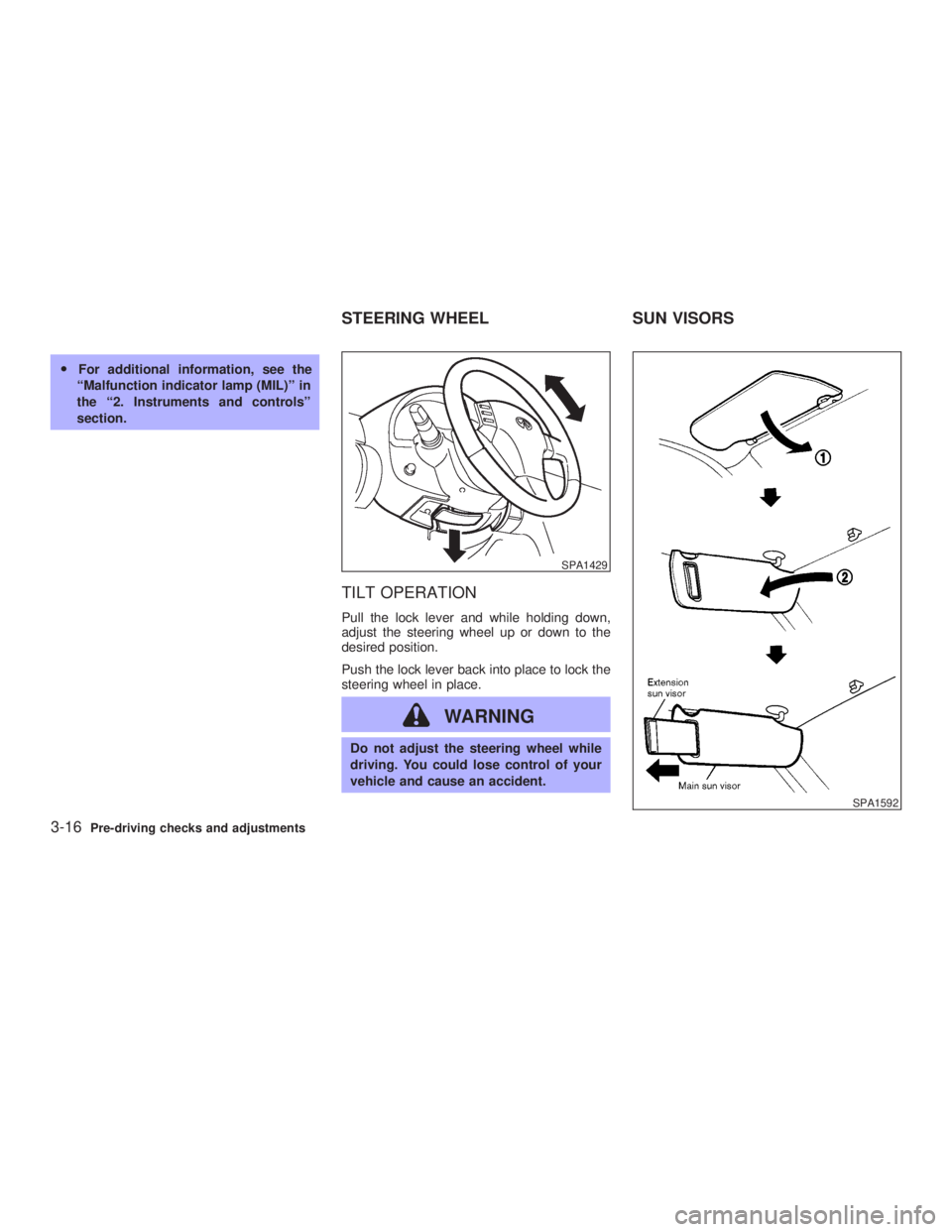
O For additional information, see the
ªMalfunction indicator lamp (MIL)º in
the ª2. Instruments and controlsº
section.
TILT OPERATION Pull the lock lever and while holding down,
adjust the steering wheel up or down to the
desired position.
Push the lock lever back into place to lock the
steering wheel in place.
WARNING Do not adjust the steering wheel while
driving. You could lose control of your
vehicle and cause an accident. SPA1429
SPA1592STEERING WHEEL SUN VISORS
3-16 Pre-driving checks and adjustments
Z 02.7.29/V35-D/V5.0
X